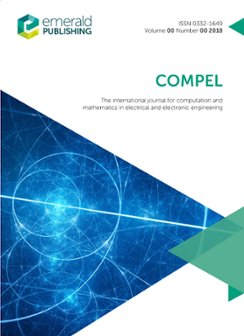COMPEL - The international journal for computation and mathematics in electrical and electronic engineering: Volume 27 Issue 6
Table of contents - Special Issue: Special Section on the Third Edition of the Italian Workshop on Finite Element Method as Applied to Electrical and Information Engineering
Guest Editors: Professor Mauro Feliziani, Professor Alessandro Salvini, Professor Alessandro Toscano, Professor Lucio Vegni
Application of a woodpile superstrate for directivity enhancement of antennas
F. Frezza, L. Pajewski, S. Paulotto, C. Ponti, G. SchettiniThe purpose of this paper is to investigate the role of electromagnetic band‐gap (EBG) materials in the enhancement of antennas' directivity.
Analysis and design of photonic crystal fibers: Solid and hollow core fibers through the finite element method
S. Selleri, A. CucinottaThe aim of this paper is to show the effectiveness of the finite element method (FEM) to study the properties of different kinds of photonic crystal fibers (PCFs), presenting…
FE‐DD based permittivity tolerance analysis in microwave waveguide filters
Giacomo Guarnieri, Giuseppe Pelosi, Lorenzo Rossi, Stefano SelleriThe paper's aim is to devise a fast method for microwave waveguide filter permittivity tolerance analysis.
Numeric simulation of a therapeutic processing: Electrostimulation of bone rebuilding
Bruno Bisceglia, Assunta De Vita, Maurizio SartiA complete analysis for illustrating the various factors responsible for electrical stimulation can provide insight about some interaction effects relationship. The paper aims to…
An assessment by a commercial software of the accuracy of electromagnetic finite element simulators in the presence of metamaterials
Giacomo Oliveri, Mirco RaffettoThe paper's purpose is to deduce additional information on the accuracy of finite element simulators for electromagnetic problems involving effective models of metamaterials.
BEM analysis of electromagnetic components filled with unconventional materials
Sebastian Emanuel Lauro, Filiberto Bilotti, Alessandro Toscano, Lucio VegniTo devise a parametric study using a new application of the boundary element method (BEM) and to propose an efficient approach for speeding up the computation time of the BEM…
A GMRES iterative solution of FEM‐BEM global systems in skin effect problems
Giovanni Aiello, Salvatore Alfonzetti, Giuseppe Borzì, Emanuele Dilettoso, Nunzio SalernoThis paper aims to extend an efficient method to solve the global system of linear algebraic equations in the hybrid finite element method – boundary element method (FEM‐BEM…
Finite element modelling of a thin‐film bulk acoustic resonator (FBAR)
Concettina Buccella, Valerio De Santis, Mauro Feliziani, Piero TognolattiThe paper aims to propose a three‐dimensional (3D) finite element analysis to evaluate the electrical performances of a FBAR (thin‐film bulk acoustic resonator) resonator.
Hybrid finite element/finite difference (FE/FD) model to analyze thermal transients in biological vascularized tissues
Valerio De Santis, Mauro Feliziani, Francescaromana MaradeiThe aim of the paper is to apply a numerical dosimetry procedure to a biological tissue with an embedded discrete vascularisation in order to evaluate the temperature increase…
Large‐signal device simulation in time‐ and frequency‐domain: a comparison
Francesco Bertazzi, Fabrizio Bonani, Simona Donati Guerrieri, Giovanni GhioneThe aim of this paper is to compare the most common time‐ and frequency‐domain numerical techniques for the determination of the steady‐state solution in the physics‐based…
Distributed computing finite element electromagnetic analysis of traveling wave tubes
Salvatore Coco, Antonino Laudani, Giuseppe PollicinoThe paper's aim is to focus on the utilization of the GRID distributed computing environment in order to reduce simulation time for parameter studies of travelling wave tube (TWT…
Quality improvement of 3‐D FE mesh by a BCA approach
S. Coco, A. Laudani, F. Riganti Fulginei, A. SalviniThe aim of this work is to show how evolutionary computation can improve the quality of 3D‐FE mesh that is a crucial task for field evaluations using 3‐D FEM analysis.
Educational value of the algebraic numerical methods in electromagnetism
Fabio Freschi, Luca Giaccone, Maurizio RepettoThe aim of this paper is to highlight the educational value of algebraic numerical methods with respect to traditional numerical techniques based on differential formulation.
Matricial techniques in the analysis of DFB laser structures
Carlos Alberto Ferreira FernandesThe aim of this paper is to develop simulation tools for the analysis of modified structures of distributed feedback (DFB) laser diodes adequate for single longitudinal mode (SLM…
Symmetrical and Clarke‐Park transformations for four‐phase systems
Francesco Della Torre, Sonia Leva, Adriano Paolo MorandoTo provide a unified analytical tool for the theoretical and practical analysis of four‐phase systems under sinusoidal condition but also under dynamic condition and to understand…
Adaptive neural network based controller for direct torque control of PMSM with minimum torque ripples and EMI noise reduction
Kayhan GulezThe paper aims to provide an adaptive neural network controller for permanent magnet synchronous motor (PMSM) under direct torque control (DTC) algorithm to minimize the torque…
Novel Padé‐based algorithms for numerical integration of ODEs
Marissa Condon, Emira Dautbegovic, Tao XuThe paper aims to propose several new approaches for the discrete‐time integration of stiff non‐linear differential equations.
Nonlinear transformer model in the frequency domain and with symmetrical components
Lieven Degroote, Lieven Vandevelde, Bert Renders, Johan GyselinckThe aim is to develop a nonlinear transformer model to achieve an accurate model to obtain the frequency components of the magnetizing current based on the harmonic voltages at…
Monte Carlo method application to evaluate the infinite integrals of underground cable earth‐return path impedance
B. Vahidi, B. Hemmatian, S.H. HosseinianTo find an easy and accurate method for evaluating the Pollaczek's integral in earth‐return path impedance calculation.
Locally coupled magneto‐mechanical model of electrical steel
A. Belahcen, A. ArkkioThe purpose of this paper is to find out how to model the effect of mechanical stresses on the magnetic properties of electrical steel used in electromagnetic devices and…
Determining the range of real eigenvalues for the interval generalized eigenvalue problem
L. KolevTo suggest a polynomial complexity method for determining the range of real eigenvalues in the case of the generalized eigenvalue problem when the elements of the matrices…

ISSN:
0332-1649Online date, start – end:
1982Copyright Holder:
Emerald Publishing LimitedOpen Access:
hybridEditor:
- Prof Jan Sykulski